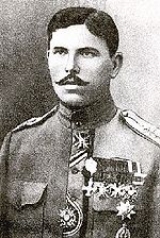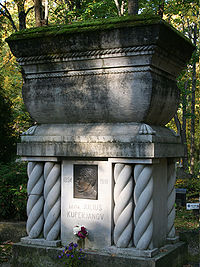
Julius Kuperjanov
Encyclopedia
Julius Kuperjanov VR II/2 and II/3 (October 11, 1894, Ljohhova near Novorzhev
, Pskov Region
, Russia
- February 2, 1919, Tartu
, Estonia
) was an Estonian military commander during the Estonian War of Independence and commanding officer of the Kuperjanov Partisan Battalion.
. At the start of World War I
, he was mobilised into the Imperial Russian Army
and commissioned after receiving basic officer training. He was wounded in both legs.
In 1917 he joined the Estonian forces during the start of the War of Independence. In December 1918, he received permission to form a ranger battalion. Students were among the first to join the Tartu County
Partisan Battalion.
On 14 January 1919, Julius Kuperjanov was among the liberators of Tartu
. He died some weeks later of wounds received leading an attack during the decisive Battle of Paju
.
 To honour Kuperjanov, the unit he had raised was renamed Kuperjanov Partisan Battalion. It was disbanded in 1940 after the Soviet occupation and re-established as the Kuperjanov Independent Infantry Battalion
To honour Kuperjanov, the unit he had raised was renamed Kuperjanov Partisan Battalion. It was disbanded in 1940 after the Soviet occupation and re-established as the Kuperjanov Independent Infantry Battalion
after Estonia regained its independence from the Soviet Union
.
Julius Kuperjanov was posthumously awarded the Cross of Liberty (VR II/2 and II/3). His tomb at Raadi cemetery
, Tartu, was one of the few Estonian monuments to survive the Soviet occupation. The monument was restored in 2008.
During the Soviet occupation of Estonia from 1940 to 1991 (in fact, Russian troops were not withdrawn from Estonia until 1994), Kuperjanov's tomb at Raadi cemetery
became a site of great symbolic significance. Dissidents and patriotically minded students would periodically gather there on various anniversaries to light candles and place flowers in Kuperjanov's memory. During the occupation period, the Soviet KGB
kept a watch on Kuperjanov's tomb, and repeatedly arrested persons who gathered there to not only honor the memory of one of Estonia's best-known heroes, but also to show that beneath the ashes of occupation, the coals of the dream of freedom were still actively glowing.
.
Novorzhev
Novorzhev is a town and the administrative center of Novorzhevsky District of Pskov Oblast, Russia, located southeast of Pskov, on the Sorot River. Population: Town status was granted to it during Catherine the Great's municipal reform of 1777....
, Pskov Region
Pskov Oblast
Pskov Oblast is a federal subject of Russia . Pskov Oblast borders the countries of Estonia and Latvia, as well as Belarus. It is the westernmost federal subject of contiguous Russia . Its major cities are the administrative center Pskov and Velikiye Luki . Area: 55,300 km²...
, Russia
Russia
Russia or , officially known as both Russia and the Russian Federation , is a country in northern Eurasia. It is a federal semi-presidential republic, comprising 83 federal subjects...
- February 2, 1919, Tartu
Tartu
Tartu is the second largest city of Estonia. In contrast to Estonia's political and financial capital Tallinn, Tartu is often considered the intellectual and cultural hub, especially since it is home to Estonia's oldest and most renowned university. Situated 186 km southeast of Tallinn, the...
, Estonia
Estonia
Estonia , officially the Republic of Estonia , is a state in the Baltic region of Northern Europe. It is bordered to the north by the Gulf of Finland, to the west by the Baltic Sea, to the south by Latvia , and to the east by Lake Peipsi and the Russian Federation . Across the Baltic Sea lies...
) was an Estonian military commander during the Estonian War of Independence and commanding officer of the Kuperjanov Partisan Battalion.
Life
Kuperjanov was a schoolteacher in the village of KambjaKambja
Kambja is a small borough in Tartu County, Estonia. It's the administrative centre of Kambja Parish.Kambja Church burned down several times, but was always rebuilt. The first mention of Kambja and the church at its present location date back to as early as 1330. After the first fire in 1558 it...
. At the start of World War I
World War I
World War I , which was predominantly called the World War or the Great War from its occurrence until 1939, and the First World War or World War I thereafter, was a major war centred in Europe that began on 28 July 1914 and lasted until 11 November 1918...
, he was mobilised into the Imperial Russian Army
Imperial Russian Army
The Imperial Russian Army was the land armed force of the Russian Empire, active from around 1721 to the Russian Revolution of 1917. In the early 1850s, the Russian army consisted of around 938,731 regular soldiers and 245,850 irregulars . Until the time of military reform of Dmitry Milyutin in...
and commissioned after receiving basic officer training. He was wounded in both legs.
In 1917 he joined the Estonian forces during the start of the War of Independence. In December 1918, he received permission to form a ranger battalion. Students were among the first to join the Tartu County
Tartu County
Tartu County , or Tartumaa , is one of 15 counties of Estonia.It is located in eastern Estonia bordering Põlva County, Valga County, Viljandi County and Jõgeva County....
Partisan Battalion.
On 14 January 1919, Julius Kuperjanov was among the liberators of Tartu
Tartu
Tartu is the second largest city of Estonia. In contrast to Estonia's political and financial capital Tallinn, Tartu is often considered the intellectual and cultural hub, especially since it is home to Estonia's oldest and most renowned university. Situated 186 km southeast of Tallinn, the...
. He died some weeks later of wounds received leading an attack during the decisive Battle of Paju
Battle of Paju
The Battle of Paju was fought in Paju, near Valga, Estonia, on 31 January 1919 during the Estonian War of Independence. After heavy fighting, the Tartu–Valga group of the Estonian Army pushed the Red Latvian Riflemen out of the Paju Manor. It was the fiercest battle in the early period of war...
.
Contemporary view

Military of Estonia
The Estonian Defence Forces is the name of the unified armed forces of the Republic of Estonia. The Estonian military is a defence force consisting of Maavägi , Merevägi , Õhuvägi and a paramilitary organization Kaitseliit...
after Estonia regained its independence from the Soviet Union
Soviet Union
The Soviet Union , officially the Union of Soviet Socialist Republics , was a constitutionally socialist state that existed in Eurasia between 1922 and 1991....
.
Julius Kuperjanov was posthumously awarded the Cross of Liberty (VR II/2 and II/3). His tomb at Raadi cemetery
Raadi cemetery
The Raadi cemetery) is one of the oldest and largest cemeteries in Tartu, in Estonia, dating from the 18th century. Many prominent historical figures from the history of Estonia are buried here. It is also the largest burial ground of the Baltic Germans in Estonia after the destruction of Kopli...
, Tartu, was one of the few Estonian monuments to survive the Soviet occupation. The monument was restored in 2008.
During the Soviet occupation of Estonia from 1940 to 1991 (in fact, Russian troops were not withdrawn from Estonia until 1994), Kuperjanov's tomb at Raadi cemetery
Raadi cemetery
The Raadi cemetery) is one of the oldest and largest cemeteries in Tartu, in Estonia, dating from the 18th century. Many prominent historical figures from the history of Estonia are buried here. It is also the largest burial ground of the Baltic Germans in Estonia after the destruction of Kopli...
became a site of great symbolic significance. Dissidents and patriotically minded students would periodically gather there on various anniversaries to light candles and place flowers in Kuperjanov's memory. During the occupation period, the Soviet KGB
KGB
The KGB was the commonly used acronym for the . It was the national security agency of the Soviet Union from 1954 until 1991, and was the premier internal security, intelligence, and secret police organization during that time.The State Security Agency of the Republic of Belarus currently uses the...
kept a watch on Kuperjanov's tomb, and repeatedly arrested persons who gathered there to not only honor the memory of one of Estonia's best-known heroes, but also to show that beneath the ashes of occupation, the coals of the dream of freedom were still actively glowing.
Stamp issue
In 2009, a commemorative stamp was issued on the occasion of the 90th anniversary of Kuperjanov's death by Eesti PostEesti Post
AS Eesti Post is the company responsible for postal service in Estonia. Eesti Post is 100% state owned .-External links:...
.

